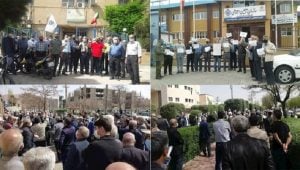
The pace of new protests is accelerating in Iran, and as it does so, expectations of nationwide unrest are growing. By all accounts, these expectations are broadly shared among the Iranian regime’s officials and its opponents. Since the first in a series of mass uprisings broke out in December 2017, Tehran has been warning about the growth in influence of the country’s leading pro-democracy opposition group, the People’s Mojahedin Organization of Iran(PMOI/MEK). The Iranian people, meanwhile, have been steadily defying warnings to resist that influence, even as the movement for regime change has been in relative stasis during the pandemic.
In a speech marking the beginning of the Iranian calendar year in March, Mrs. Maryam Rajavi the President-elect of NCRI speculated that this period of diminished activity will not last very long. It seems clear that the effects of the initial uprising would have continued well into 2020, and perhaps up to the present date, if not for the unfamiliar challenges of public organizing associated with the spreading coronavirus. Iran has suffered one of the worst outbreaks in the entire world, and the regime adopted a hands-off public health policy deliberately, in hopes that fear of infection would prevent people from continuing to gathering in large numbers, across multiple cities.
Tehran certainly did not follow an international standard for intervention regarding the coronavirus. Lockdowns were imposed after an initial period of disinformation, but even then they were weak and inconsistently enforced. Meanwhile, the regime’s similarly dismissive economic policies made it virtually impossible for most Iranians to comply with lockdowns anyway since it was necessary for them to work in order to avoid homelessness or starvation.
The National Council of Resistance of Iran has issued a number of statements since the beginning of the pandemic which emphasized that hundreds of billions of dollars in financial assets were available for a government response. The statements referred both to the religious foundations maintained by the regime’s Supreme Leader Ali Khamenei and to the Islamic Revolutionary Guard Corps’ private sector activities and front companies. Instead of being used to support the population during a period of home isolation, nearly all of these funds remained in reserve, presumably for use in self-serving policy initiatives such as IRGC-led interventions in surrounding conflict zones.
This neglect of the people’s vital needs may have made mass demonstrations less likely, but of course, it also left the population with even more intense grievances one year later. This is becoming more and more evident from recent protests that have placed their emphasis on worsening economic indicators and growing difficulty in meeting the basic necessities of life.
Since at least the beginning of 2021, some of the most committed representatives of this sentiment have been Iran’s pensioners and retirees. Many are unable to work while others are simply at the back of the line for employment in an economy that has consigned well over half the civilian population to abject poverty. Thus, pensioners have little recourse but to raise the profile of that situation in the minds of fellow Iranians, as well as the international community. Their protests have taken place across all major cities and various towns, albeit in a more staggered and loosely-connected fashion than the December 2017 uprisings and its follow-ups.
April 24 – Tehran, #Iran
Oppressive regime forces attack protesting investors.#IranProtests pic.twitter.com/pLfFy6aiC4— People's Mojahedin Organization of Iran (PMOI/MEK) (@Mojahedineng) April 24, 2021
In recent days, the pensioners have been joined by other groups that have been nearly as ill-affected by the Iranian regime’s economic policies, especially during the pandemic. The social diversity of these groups is remarkable, as it includes everything from poor, rural farmers to investors who formerly counted themselves among Iran’s rapidly shrinking middle class. For their part, farmers have highlighted the ways in which the government’s close connections to the private sector have led to their needs being marginalized through such things as the deprivation of water rights. Investors, meanwhile, have been protesting over a government scheme to flood the market at the height of the pandemic – as scheme that allowed well-connected individuals to profit over the short term while newer investors were essentially cleaned out.
Despite the pandemic and the regime’s repressive measures, they rose again today, held protests and strikes and marched to demand their usurped rights. Various strata of people in #Iran hold protests every day. #IranProtests pic.twitter.com/5vcgx7eQMJ
— Maryam Rajavi (@Maryam_Rajavi) April 24, 2021
The past year’s relative lull in activity suggests that the pandemic was the only thing that could provide the regime with any cover from public outrage. But the ongoing pensioner protests and the new demonstrations from investors, farmers, and other groups suggest that this effect is running its course. Now, with the Iranian regime’s sham presidential election looming, the expressions of economic grievance are beginning to take on broader political messaging, much like they did at the beginning of 2018.
Specifically, the above-mentioned groups have begun endorsing calls for an electoral boycott – an effort that is being led, as in years past, by the MEK. The MEK’s “Resistance Units” inside Iran have lately been placing posters and graffiti in public spaces with slogans that condemn all the regime’s elections as a “sham” and emphasize the folly of putting faith in any set of regime insiders to bring an end to the country’s political, economic, or public health crises.
In many cases, those slogans are accompanied by images of Mrs. Rajavi and Mr. Massoud Rajavi. As they did in advance of Iran’s February 2020 parliamentary elections, which saw the lowest voter turnout in the history of Iran, the Resistance Units have made it clear that by sitting out the elections and denying legitimacy to the clerical dictatorship, the Iranian people can make clear: “My vote is for regime change.”



